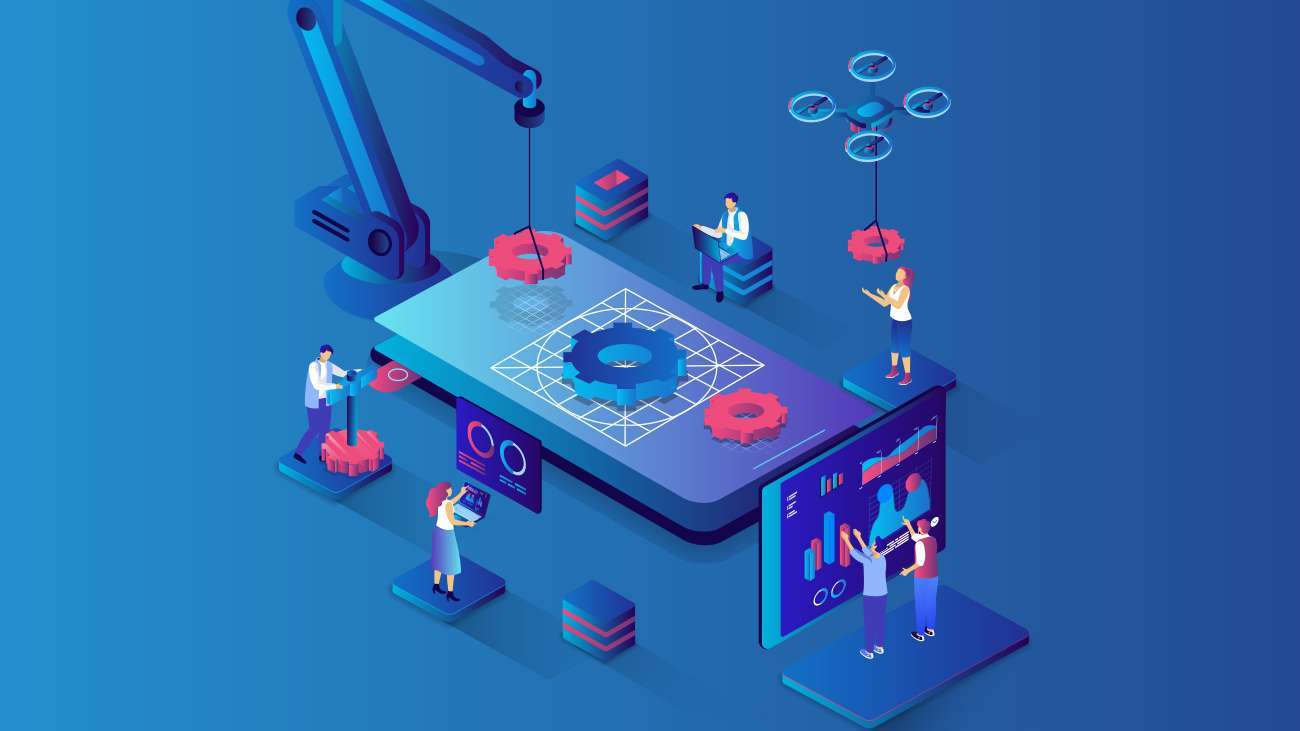
What is Application development and maintenance?
In today’s digital era, businesses rely on software applications to drive operations, enhance productivity, and deliver exceptional user experiences. Application development and maintenance play a pivotal role in enabling organizations to harness the full potential of technology. From conceptualizing and building custom applications to ensuring their smooth functioning and ongoing updates, this blog explores the significance of application development and maintenance in driving business growth and success.
What is Application Development?
Application development refers to creating software applications to meet specific needs or requirements. It involves designing, programming, and implementing a solution that addresses a particular problem or enhances a specific function within an organization. Application development encompasses various stages, including gathering requirements, designing the application architecture, coding, testing, and deployment. It may involve programming languages, frameworks, libraries, and development tools to build functional and user-friendly applications. The goal of application development is to create efficient, scalable, and reliable software solutions that meet the unique needs of businesses and users.
What is Application Maintenance?
Application maintenance refers to the ongoing process of managing, updating, and supporting software applications after their initial development and deployment. It involves monitoring the application’s performance, functionality, and security to ensure its smooth operation and optimal user experience. Application maintenance includes bug fixes, software updates, performance enhancements, security patches, and user support.
Main Steps in Application Development Process

The application development process typically consists of several key steps, each contributing to a software application’s successful creation and deployment. While the specific approach may vary depending on the development methodology and project requirements, the following steps outline a typical application development process:
Planning and Research
The first step involves thorough planning and researching to understand project requirements, user needs, and market trends. This phase helps define the application development project’s scope, objectives, and feasibility.
Design and Prototyping
Once the requirements are gathered, the development team designs the application’s architecture, user interface, and overall user experience. Prototyping is often used to create visual representations and interactive models of the application for feedback and validation.
Code Development
In this phase, the actual coding and programming take place. Developers write the application’s code based on the design specifications, employing appropriate programming languages, frameworks, and development tools. Close collaboration and adherence to coding standards are critical for efficient and maintainable code development.
Testing and Optimization
The application undergoes rigorous testing to identify and fix any bugs, errors, or issues. Various testing techniques, such as unit, integration, and performance, are employed to ensure the application functions as intended. Optimization efforts focus on improving performance, efficiency, and user experience.
Release and Maintenance
Once the application passes testing and quality assurance, it is released and made available to users. Ongoing maintenance and support are crucial to address bugs, implement updates, and ensure the application remains secure and performs optimally. Regular monitoring and user feedback help identify areas for improvement and drive future enhancements.
Types of application development

Rapid Application Development (RAD)
Rapid Application Development (RAD) focuses on accelerating the development process using rapid prototyping, iterative development, and close collaboration between developers and stakeholders. RAD emphasizes the quick delivery of functional software through shorter development cycles. It often involves visual development tools, reusable components, and automated code generation to speed up development. RAD is suitable for projects that require fast turnaround times and frequent iterations to meet evolving business needs.
Custom Application Development
Custom application development involves creating customized software solutions to meet unique business requirements. Custom applications are built from scratch, considering the organization’s specific workflows, processes, and objectives. The development team collaborates closely with stakeholders to understand their needs and design a solution that provides the desired functionalities and user experience. Custom application development allows businesses to have full control over the software’s features, scalability, and integration capabilities, ensuring a precise fit for their specific needs.
Database Application Development
Database application development focuses on creating applications that interact with databases to manage and manipulate data efficiently. These applications are designed to store, retrieve, update, and analyze data using database management systems (DBMS). Database application development involves designing schemas, creating data models, implementing data access and manipulation logic, and ensuring data integrity and security. These applications are commonly used for data entry, reporting, analysis, and data-driven decision-making.
Enterprise Application Development
Enterprise application development focuses on creating robust and scalable software solutions to support large-scale organizations. These applications are designed to address complex business processes and cater to multiple departments within an enterprise. Enterprise applications often involve integrating various systems and databases to streamline operations, enhance collaboration, and improve efficiency. They can encompass functions such as customer relationship management (CRM), enterprise resource planning (ERP), supply chain management (SCM), and human resources management (HRM). Enterprise application development requires in-depth business requirements analysis, extensive planning, and a comprehensive understanding of the organization’s structure and processes.
Web Application Development
Web application development involves creating software applications that are accessed through web browsers. These applications are typically hosted on web servers and provide interactive and dynamic functionalities to users over the internet or intranet. Web applications range from simple websites with interactive features to complex web-based software solutions. They are designed to be platform-independent and accessible from different devices and operating systems. Web application development encompasses front-end development involving HTML, CSS, and JavaScript, back-end development using programming languages like Python, Java, or PHP, and database integration. Web applications are widely used for e-commerce, online collaboration, content management systems (CMS), and various other web-based application development services.
Citizen Application Development
Citizen application development refers to creating applications by non-technical individuals, often known as citizen developers, with limited or no coding experience. To build functional applications, citizen developers use low-code or no-code platforms that provide visual interfaces, pre-built components, and drag-and-drop functionality. These platforms abstract the complexities of coding and enable citizen developers to create basic applications quickly. Citizen application development empowers business users to address their specific needs or automate simple workflows without relying on dedicated development teams. It promotes collaboration and innovation within organizations by allowing individuals to build applications specific to their departmental or individual requirements.
Benefits of Application Development and Maintenance

Customized Solutions
Application development allows businesses to create tailored software solutions that address their needs and requirements. Custom applications provide a competitive advantage by aligning with unique workflows, processes, and objectives, improving efficiency and productivity.
Improved Efficiency and Productivity
Well-designed applications streamline business operations, automate manual tasks, and provide intuitive user interfaces. By optimizing workflows and eliminating redundant processes, application development enhances productivity and allows employees to focus on core responsibilities, resulting in time and cost savings.
Enhanced User Experience: User-centric application development prioritizes the user experience, resulting in intuitive and user-friendly interfaces. Applications that are easy to navigate and provide a seamless user experience contribute to customer satisfaction, increased engagement, and higher adoption rates.
Scalability and Adaptability
Applications can be designed to be scalable, allowing for easy expansion as the business grows. They can also be adapted to accommodate changing business needs, new functionalities, or technological advancements. This flexibility ensures that applications remain relevant and capable of meeting evolving requirements.
Increased Data Security
Application development incorporates robust security measures to protect sensitive data and systems. By following best practices and implementing security protocols, applications can safeguard against data breaches, unauthorized access, and other security risks. Regular maintenance includes security updates and patches to address vulnerabilities, ensuring data confidentiality and integrity.
The Future of Application Development and Maintenance
The future of application development and maintenance will witness significant advancements and transformations fueled by emerging technologies, changing business needs, and evolving development practices. Keywise Technology is poised to be crucial in shaping this future landscape.
With the integration of emerging technologies such as artificial intelligence (AI), machine learning (ML), blockchain, the Internet of Things (IoT), and augmented reality (AR), applications will become more intelligent, interactive, and capable of delivering enhanced user experiences. Keywise Technology’s expertise in these technologies positions it to lead the way in incorporating them into application development, unlocking new possibilities and driving innovation.
Furthermore, the rise of low-code and no-code development platforms empowers citizen developers and business users to create applications without extensive coding knowledge. Keywise Technology can embrace these platforms, providing support, training, and expertise to enable rapid application development, collaboration, and innovation within organizations. By leveraging these platforms, Keywise Technology can expedite development and empower businesses to create applications more efficiently.
Conclusion
In conclusion, application development is creating software applications to meet specific business needs, while application maintenance involves managing and supporting those applications over time. These two processes are essential for businesses to leverage technology, enhance productivity, and stay competitive in the digital era. Application development enables the creation of custom solutions that address unique requirements, while maintenance ensures the ongoing reliability, security, and performance of the applications. By investing in development and maintenance, businesses can optimize operations, deliver exceptional user experiences, and adapt to changing market demands.
FAQs
- How does application development work?
Application development typically follows a structured process that involves several stages. It begins with gathering requirements, conducting research, and designing the application’s architecture and user interface. Then, developers write the code to bring the application to life, and rigorous testing is conducted to identify and fix any issues. Once the application passes testing, it is deployed, and ongoing maintenance and updates ensure its smooth operation.
- What does an application developer do?
An application developer is responsible for designing, coding, testing, and deploying software applications. They work closely with stakeholders to understand requirements, develop application architecture, write efficient code, and ensure the application meets functional and user experience expectations. Application developers also collaborate with other team members, such as designers and testers, to ensure the successful development and delivery of the application.
- What are application development use cases?
Application development can have various use cases across industries and sectors. Some common use cases include:
-
-
- Mobile Applications: Developing mobile apps for platforms like iOS and Android, offering services, entertainment, social networking, productivity, or gaming.
- Web Applications: Creating web-based applications accessed through web browsers for e-commerce, content management, or collaboration tools.
- Enterprise Applications: Building comprehensive solutions for large organizations to support functions like customer relationship management (CRM), enterprise resource planning (ERP), or supply chain management (SCM).
- Data Management Applications: Develop applications to handle and manipulate large datasets, perform data analysis, or manage databases efficiently.
- Custom Business Applications: Creating bespoke applications tailored to an organization’s specific business needs and workflows.
-
- How much does it cost to develop an application?
The application development cost varies based on several factors, including complexity, features, platform (iOS, Android, or both), design, and development time. Simple apps with basic features may cost less, while complex apps with advanced functionalities can be more expensive. It is recommended to consult with app development agencies or developers to get accurate cost estimates based on specific requirements.
- What is the best programming language for application development?
The choice of programming language depends on various factors, including the type of application, platform, project requirements, and developer’s familiarity with the language. Some commonly used programming languages for application development include:
-
-
- Java: Widely used for Android app development, enterprise applications, and scalable systems.
- Swift: Used for iOS app development, specifically for Apple platforms.
- JavaScript: Used for web and mobile app development, often combined with frameworks like React or Angular.
- Python: Known for its simplicity and versatility, used for web development, data analysis, and scripting.
- C#: Used mainly for Windows and Microsoft ecosystem applications, including desktop and enterprise applications.
-

